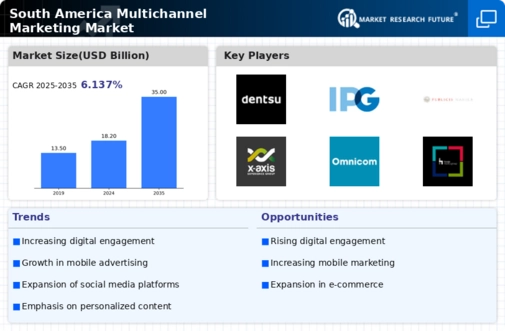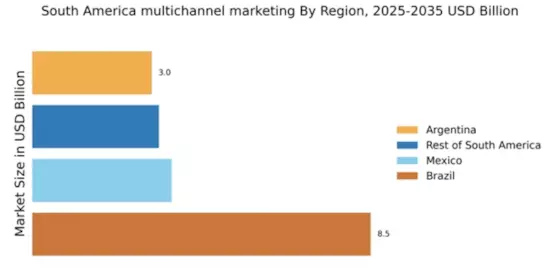The multichannel marketing market in South America is characterized by a dynamic competitive landscape, driven by rapid technological advancements and evolving consumer preferences. Key players such as Salesforce (US), Adobe (US), and HubSpot (US) are at the forefront, leveraging innovative solutions to enhance customer engagement and streamline marketing efforts. Salesforce (US) focuses on integrating AI capabilities into its platforms, thereby enabling businesses to personalize customer interactions more effectively. Meanwhile, Adobe (US) emphasizes creative cloud solutions that facilitate seamless content creation across multiple channels, positioning itself as a leader in digital marketing. HubSpot (US) adopts a customer-centric approach, offering comprehensive tools that cater to small and medium-sized enterprises, thus expanding its market reach and fostering brand loyalty.
The business tactics employed by these companies reflect a concerted effort to optimize operations and enhance market presence. The competitive structure of the market appears moderately fragmented, with several players vying for dominance. This fragmentation allows for diverse strategies, as companies localize their offerings to meet regional demands while optimizing supply chains to improve efficiency. The collective influence of these key players shapes the market dynamics, fostering an environment where innovation and customer engagement are paramount.
In October 2025, Salesforce (US) announced a strategic partnership with a leading South American telecommunications provider to enhance its service offerings. This collaboration aims to integrate advanced analytics and AI-driven insights into marketing campaigns, thereby improving customer targeting and engagement. The strategic importance of this partnership lies in its potential to expand Salesforce's footprint in the region, allowing it to tap into a broader customer base and enhance its competitive edge.
In September 2025, Adobe (US) launched a new suite of tools specifically designed for the South American market, focusing on local languages and cultural nuances. This initiative underscores Adobe's commitment to localization, enabling businesses to create more relevant and impactful marketing campaigns. The strategic significance of this move is evident in its potential to strengthen Adobe's market position by catering to the unique needs of South American consumers, thereby fostering deeper connections between brands and their audiences.
In August 2025, HubSpot (US) introduced a new pricing model aimed at making its services more accessible to startups and small businesses in South America. This strategic shift not only broadens HubSpot's customer base but also enhances its competitive positioning against other players in the market. By lowering entry barriers, HubSpot is likely to capture a larger share of the growing small business segment, which is increasingly turning to digital marketing solutions.
As of November 2025, the competitive trends in the multichannel marketing market are heavily influenced by digitalization, sustainability, and the integration of AI technologies. Strategic alliances are becoming increasingly vital, as companies seek to enhance their capabilities and expand their market reach. The shift from price-based competition to a focus on innovation, technology, and supply chain reliability is evident, suggesting that future competitive differentiation will hinge on the ability to deliver unique, value-driven solutions that resonate with consumers.


















Leave a Comment